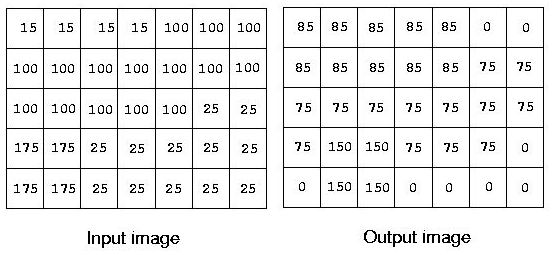POJ 1009 Edge Detection(模拟)
来源:互联网 发布:usb摄像头和网络摄像头 编辑:程序博客网 时间:2024/06/05 19:29
Edge Detection
Time Limit: 1000MS Memory Limit: 10000KTotal Submissions: 17586 Accepted: 4020
Description
IONU Satellite Imaging, Inc. records and stores very large images using run length encoding. You are to write a program that reads a compressed image, finds the edges in the image, as described below, and outputs another compressed image of the detected edges.
A simple edge detection algorithm sets an output pixel's value to be the maximum absolute value of the differences between it and all its surrounding pixels in the input image. Consider the input image below:

The upper left pixel in the output image is the maximum of the values |15-15|,|15-100|, and |15-100|, which is 85. The pixel in the 4th row, 2nd column is computed as the maximum of |175-100|, |175-100|, |175-100|, |175-175|, |175-25|, |175-175|,|175-175|, and |175-25|, which is 150.
Images contain 2 to 1,000,000,000 (109) pixels. All images are encoded using run length encoding (RLE). This is a sequence of pairs, containing pixel value (0-255) and run length (1-109). Input images have at most 1,000 of these pairs. Successive pairs have different pixel values. All lines in an image contain the same number of pixels.
A simple edge detection algorithm sets an output pixel's value to be the maximum absolute value of the differences between it and all its surrounding pixels in the input image. Consider the input image below:

The upper left pixel in the output image is the maximum of the values |15-15|,|15-100|, and |15-100|, which is 85. The pixel in the 4th row, 2nd column is computed as the maximum of |175-100|, |175-100|, |175-100|, |175-175|, |175-25|, |175-175|,|175-175|, and |175-25|, which is 150.
Images contain 2 to 1,000,000,000 (109) pixels. All images are encoded using run length encoding (RLE). This is a sequence of pairs, containing pixel value (0-255) and run length (1-109). Input images have at most 1,000 of these pairs. Successive pairs have different pixel values. All lines in an image contain the same number of pixels.
Input
Input consists of information for one or more images. Each image starts with the width, in pixels, of each image line. This is followed by the RLE pairs, one pair per line. A line with 0 0 indicates the end of the data for that image. An image width of 0 indicates there are no more images to process. The first image in the example input encodes the 5x7 input image above.
Output
Output is a series of edge-detected images, in the same format as the input images, except that there may be more than 1,000 RLE pairs.
Sample Input
715 4100 1525 2175 225 5175 225 50 01035 500000000200 5000000000 03255 110 1255 210 1255 210 1255 10 00
Sample Output
785 50 285 575 10150 275 30 2150 20 40 0100 499999990165 200 4999999900 03245 90 00
Hint
A brute force solution that attempts to compute an output value for every individual pixel will likely fail due to space or time constraints.
AC代码:
#include <cstdio>#include <cmath>#include <algorithm>using namespace std;int w,tot,k,b;struct node{int pos; int ans; }out[10010],in[1001];int cmp(node x,node y){return x.pos<y.pos;}int gg(int x){int p,i;p=0;i=0;while(p<x)p+=in[i++].ans;return in[i-1].pos;}int so(int x){int n,ans=0,i,j,q,t,h,l;n=gg(x);h=(x-1)/w;l=(x-1)%w;for (i=h-1;i<=h+1;i++){for (j=l-1;j<=l+1;j++){q=i*w+j;if (i<0||j<0||j>=w||q>=tot||q+1==x)continue;t=gg(q+1);if (ans<abs(t-n))ans=abs(t-n);}}return ans;}void getans(){int i,j,q,we,n,h,l;q=1;k=0;for(n=0;n<=b;n++){h=(q-1)/w;l=(q-1)%w;for(i=h-1;i<=h+1;i++){for (j=l-1;j<=l+1;j++){we=i*w+j;if (i<0 || j<0 || j>=w || we>=tot)continue;out[k].pos=we+1;out[k++].ans=so(we+1);}}q+=in[n].ans;}}void putans(){int i,j;sort(out,out+k,cmp);node t;t=out[0];for(i=0;i<k;i++){if (out[i].ans==t.ans)continue;printf("%d %d\n",t.ans,out[i].pos-t.pos);t=out[i];}printf("%d %d\n",t.ans,tot-t.pos+1);printf("0 0\n");}int main(){while(scanf("%d",&w),w){int num,len,i;b=tot=0;while(scanf("%d%d",&num,&len),len){in[b].pos=num;in[b++].ans=len;tot+=len;}printf("%d\n",w);getans();putans();}printf("0\n");return 0;} 0 0
- POJ 1009 Edge Detection(模拟)
- poj 1009 Edge Detection(模拟)
- poj 1009 Edge Detection 模拟
- POJ 1009 Edge Detection
- poj 1009 Edge Detection
- poj 1009 Edge Detection
- POJ 1009 Edge Detection
- POJ-1009-Edge Detection
- [POJ][1009]Edge Detection
- POJ 1009: Edge Detection
- POJ 1009 Edge Detection
- POJ 1009--Edge Detection
- POJ 1009Edge Detection
- POJ 1009 Edge Detection
- POJ 1009--Edge Detection
- POJ 1009 Edge Detection
- poj 1009 Edge Detection (未完成)
- POJ 1009 Edge Detection 笔记
- android Touch事件传递自己理解
- 相机闪存卡数据恢复方法/数码相机误删照片恢复详解
- POJ 3566
- No.10 Xcode(5.1.x) UITabBarController
- Hdu 1043
- POJ 1009 Edge Detection(模拟)
- 如何使用KeyChain保存和获取UDID
- Digital Roots——ZOJ 1115
- vc6.0与vs2010库文件添加
- C语言的本质(23)——C标准库之输入与输出(上)
- dfadfafa
- 批处理中set截取字符详解
- 数据挖掘笔记-特征选择-信息增益
- Codeforces Round #253 (Div. 2)——Borya and Hanabi


